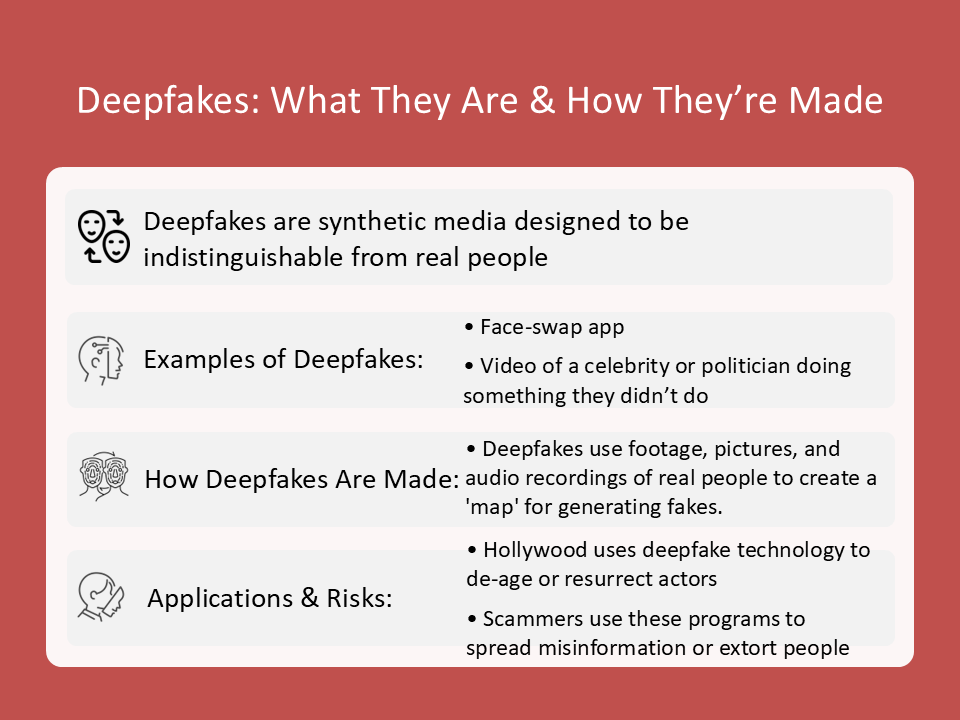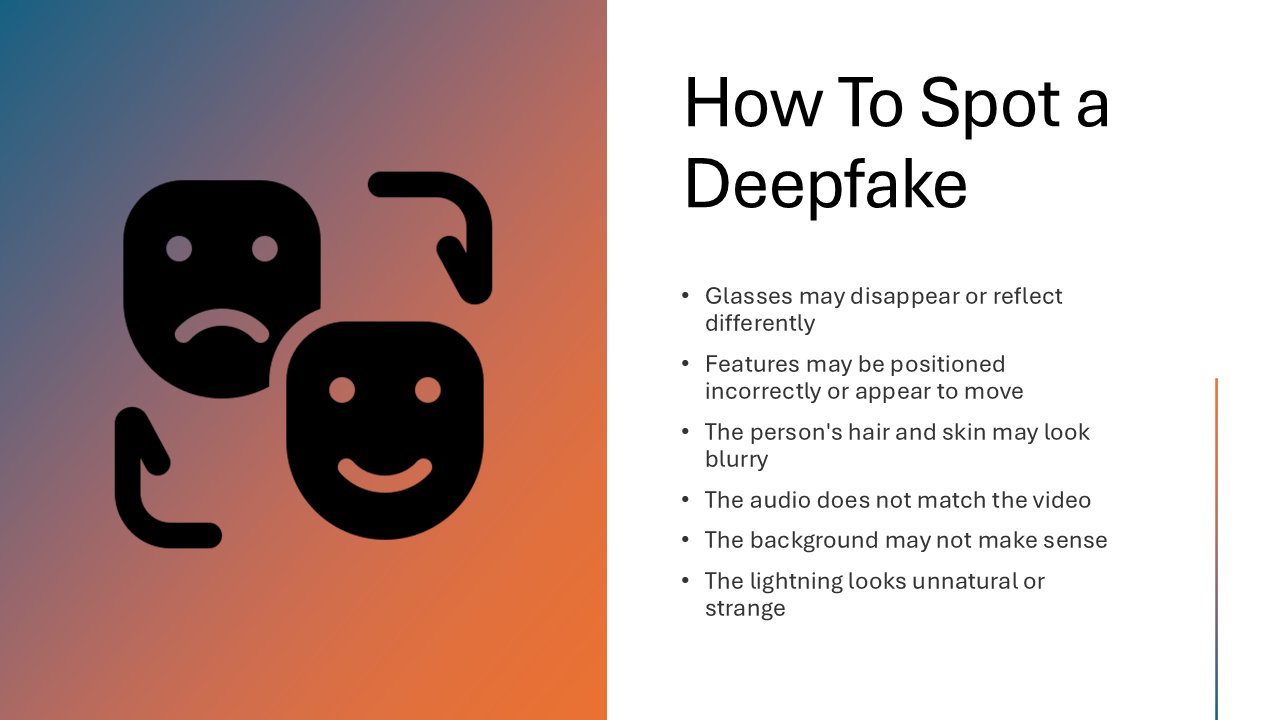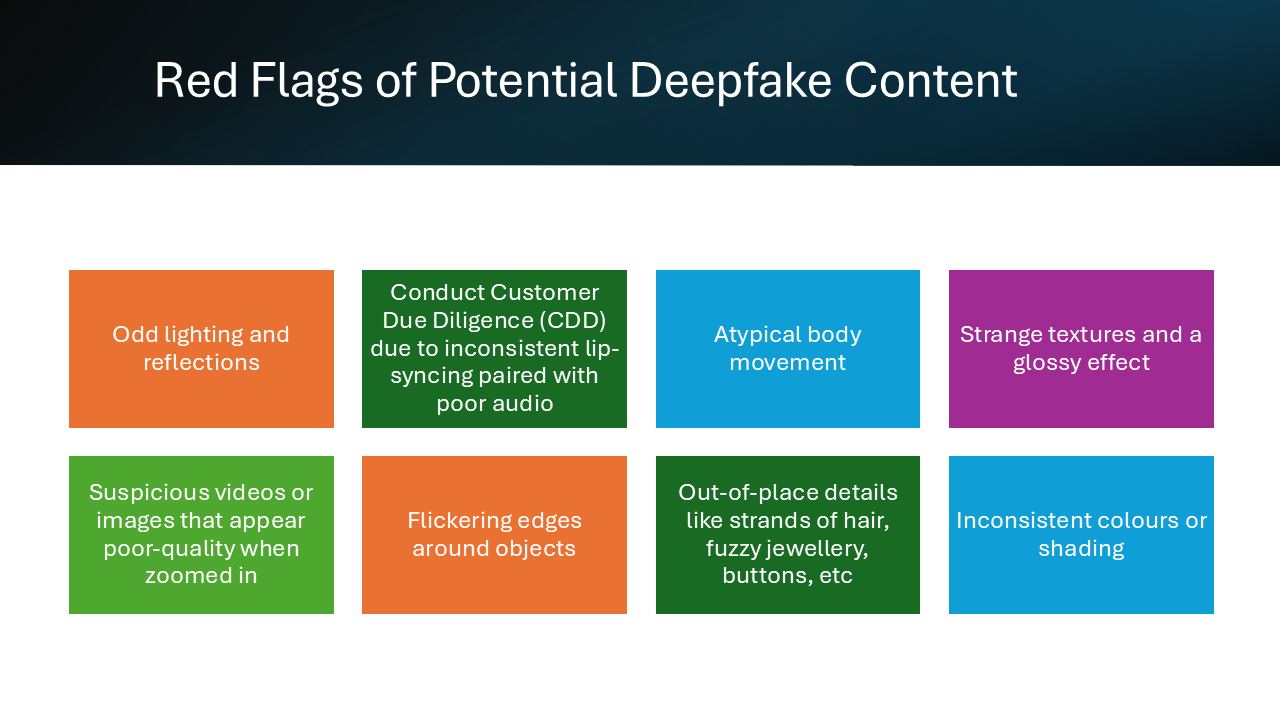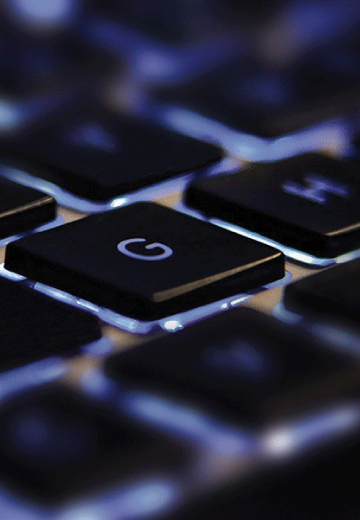Artificial Intelligence (AI) has revolutionised entertainment, bringing new life to movies, games, and other media through stunning visual effects and animations. However, there is also a darker side to this technology. Deepfakes —AI-generated fake videos, images, and audio —blur the line between real and fake media, raising major ethical and security concerns.
What Are Deepfakes?
At their core, deepfakes are AI-generated fake media content. Using techniques such as deep learning and neural networks, computers analyze large datasets—like videos, images, and audio—to replicate human appearances, expressions, and even voices with impressive accuracy. Deepfake technology can swap faces in videos, alter speech, or even create entirely new conversations that look and sound real, making it increasingly difficult to distinguish truth from fiction.
While this AI technology can have creative applications, such as digitally de-aging actors in movies or creating virtual characters in games, deepfakes are unfortunately often used in ways that harm others.
 Figure 1: What deepfakes are and how they are made. Adapted from: https://us.norton.com/blog/emerging-threats/what-are-deepfakes.
Figure 1: What deepfakes are and how they are made. Adapted from: https://us.norton.com/blog/emerging-threats/what-are-deepfakes.
The Dark Side of Deepfakes
While deepfakes were initially developed for entertainment, they are now widely used to deceive people and cause harm. Here are some of the major concerns associated with them:
Figure 2: Some examples of what deepfakes are used for. Adapted from: https://www.fortinet.com/resources/cyberglossary/deepfake.
Real-World Examples
Deepfakes have already caused significant harm in various real-world scenarios:

Figure 3: Ways to spot a deepfake. Adapted from: https://us.norton.com/blog/emerging-threats/what-are-deepfakes
Case Studies
Case Study 1: Nancy Pelosi Deepfake
Case Study 2: Ukrainian Politician's Deepfake Scandal
Case Study 3: AI-Generated Voice Scams
Case Study 4: Deepfake Pornography Figure 4: Some use case examples of fraudulent deepfakes. Adapted from: https://www.idenfy.com/blog/what-are-deepfakes/.
Figure 4: Some use case examples of fraudulent deepfakes. Adapted from: https://www.idenfy.com/blog/what-are-deepfakes/.

Figure 5: Some red flags of potential deepfake content. Adapted from: https://www.idenfy.com/blog/what-are-deepfakes/.
Conclusion
Deepfakes highlight both the incredible potential and the serious risks of AI. While they open up exciting possibilities for creativity, they also pose real threats to individuals and society. As this technology advances, it is vital to develop effective ways to manage its risks through detection tools, regulations and public education. By doing so, we can help curb the misuse of deepfakes and work towards a safer and more trustworthy digital future.
References
What Are Deepfakes?
At their core, deepfakes are AI-generated fake media content. Using techniques such as deep learning and neural networks, computers analyze large datasets—like videos, images, and audio—to replicate human appearances, expressions, and even voices with impressive accuracy. Deepfake technology can swap faces in videos, alter speech, or even create entirely new conversations that look and sound real, making it increasingly difficult to distinguish truth from fiction.
While this AI technology can have creative applications, such as digitally de-aging actors in movies or creating virtual characters in games, deepfakes are unfortunately often used in ways that harm others.
 Figure 1: What deepfakes are and how they are made. Adapted from: https://us.norton.com/blog/emerging-threats/what-are-deepfakes.
Figure 1: What deepfakes are and how they are made. Adapted from: https://us.norton.com/blog/emerging-threats/what-are-deepfakes.The Dark Side of Deepfakes
While deepfakes were initially developed for entertainment, they are now widely used to deceive people and cause harm. Here are some of the major concerns associated with them:
- Spreading False Information: Deepfakes are powerful tools for spreading fake news. Fabricated videos of politicians or celebrities can make them appear to say or do things they never did, manipulating public opinion and promoting false information.
- Identity Theft: By replicating someone’s face or voice, deepfakes can facilitate identity theft. Criminals can create fake videos or audio clips of someone and use them for blackmail or fraud.
- Reputation Damage: Deepfakes can severely damage reputations. For instance, a fake video of a celebrity or a public official engaging in inappropriate behavior can destroy careers and personal lives.
- National Security Risks: Deepfakes can pose threats to national security. They could be used to impersonate government officials or issue fake orders, potentially destabilising public trust in institutions.

Figure 2: Some examples of what deepfakes are used for. Adapted from: https://www.fortinet.com/resources/cyberglossary/deepfake.
Real-World Examples
Deepfakes have already caused significant harm in various real-world scenarios:
- Fake Celebrity Videos: Numerous fake videos have surfaced showing celebrities endorsing products or making statements they never actually made. These videos often spread quickly on social media, deceiving fans, and damaging the celebrity’s reputation.
- Political Manipulation: During elections or political crises, deepfake videos of politicians delivering speeches or interviews have been used to manipulate public opinion. For example, during Ukraine crisis, a deepfake of President Zelensky appeared online, falsely depicting him instructing soldiers to surrender.
- Voice Scams: Scammers have leveraged deepfake audio to mimic the voices of company executives, tricking employees into transferring money to fraudulent accounts.
- Deepfake Pornography: AI has also been used to create fake pornographic videos featuring non-consenting individuals, often celebrities, causing significant emotional and reputational damage.
How to Spot a Deepfake
With advancing technology, spotting deepfakes can be challenging, but there are still telltale signs:- Visual Artifacts: Deepfakes often contain subtle visual glitches, like blurred edges around the face, odd lighting, or inconsistent shadows.
- Unnatural Movements: Deepfake videos may not perfectly mimic natural movements, especially around the eyes or mouth.
- Audio Inconsistencies: The audio in a deepfake may sound slightly off, with unusual pauses or mismatched lip movements.
- Source Checking: If the content appears suspicious, comparing it with original or verified footage of the person can reveal discrepancies.

Figure 3: Ways to spot a deepfake. Adapted from: https://us.norton.com/blog/emerging-threats/what-are-deepfakes
Case Studies
Case Study 1: Nancy Pelosi Deepfake
- A manipulated video of U.S. House Speaker Nancy Pelosi was slowed down to make her appear intoxicated and slurring her words.
- The video went viral, causing widespread misinformation and negatively impacting Pelosi’s public image.
- Sources: https://edition.cnn.com/interactive/2020/10/us/manipulated-media-tech-fake-news-trnd/ and https://www.youtube.com/watch?v=CErxzDYPjyE
Case Study 2: Ukrainian Politician's Deepfake Scandal
- A Deepfake video of Ukrainian President Volodymyr Zelensky surfaced, falsely showing him ordering troops to surrender during the Russian invasion.
- Authorities quickly debunked the video, but the damage was done as it briefly influenced public perception.
- Source: https://www.reuters.com/world/europe/deepfake-footage-purports-show-ukrainian-president-capitulating-2022-03-16/
Case Study 3: AI-Generated Voice Scams
- Scammers used AI-generated voice technology to impersonate CEOs in phone calls, deceiving employees into transferring money or disclosing sensitive information.
- Sources: https://www.youtube.com/watch?v=pJZYd_65xs4 and https://www.scworld.com/news/deepfake-video-conference-convinces-employee-to-send-25m-to-scammers
Case Study 4: Deepfake Pornography
- AI-generated pornographic videos featuring non-consenting individuals, often celebrities, have been created, causing immense harm to victims.
- Sources: https://www.youtube.com/watch?v=uyH-giAFWdI and https://abcnews.go.com/US/white-house-calls-legislation-regulate-ai-amid-explicit/story?id=106718520
 Figure 4: Some use case examples of fraudulent deepfakes. Adapted from: https://www.idenfy.com/blog/what-are-deepfakes/.
Figure 4: Some use case examples of fraudulent deepfakes. Adapted from: https://www.idenfy.com/blog/what-are-deepfakes/. How Can We Combat Deepfakes?
Deepfake technology is evolving fast, but there are some ways to manage its misuse:- AI Detection Tools: New AI-powered tools are being developed to detect deepfakes. These tools look for inconsistencies in video or audio files that might go unnoticed, like unnatural facial movements.
- Regulation and Legislation: Governments are creating laws to address deepfakes. Some jurisdictions now have rules that penalise malicious deepfakes used for identity theft, fraud, or defamation.
- Public Awareness: Raising awareness about deepfakes is essential. Individuals and institutions need to understand the risks and learn how to identify suspicious content.
- Collaboration: Collaboration between tech companies, governments, and researchers is crucial. Social media platforms like Facebook and YouTube are implementing measures to detect and remove harmful deepfakes.

Figure 5: Some red flags of potential deepfake content. Adapted from: https://www.idenfy.com/blog/what-are-deepfakes/.
Conclusion
Deepfakes highlight both the incredible potential and the serious risks of AI. While they open up exciting possibilities for creativity, they also pose real threats to individuals and society. As this technology advances, it is vital to develop effective ways to manage its risks through detection tools, regulations and public education. By doing so, we can help curb the misuse of deepfakes and work towards a safer and more trustworthy digital future.
References
- https://www.trymaverick.com/blog-posts/are-deep-fakes-all-evil-when-can-they-be-used-for-good
- https://cs231n.stanford.edu/2024/papers/deep-learning-deepfake-detection.pdf
- https://www.pyrratech.com/articles/the-dark-side-of-ai-generated-content-deep-fakes-and-unmoderated-social
- https://www.theguardian.com/technology/ng-interactive/2019/jun/22/the-rise-of-the-deepfake-and-the-threat-to-democracy
- https://mashable.com/article/deepfake-impersonation-tech-easy-to-make
- https://spyscape.com/article/why-deepfakes-are-a-national-security-threat

